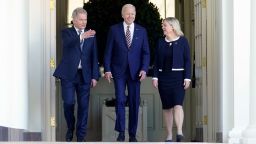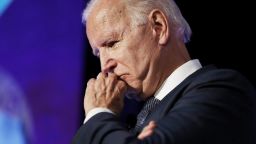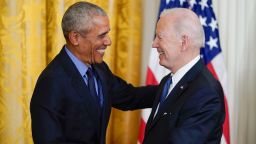Editor’s Note: Julian Zelizer, a CNN political analyst, is a professor of history and public affairs at Princeton University. He is the author and editor of 24 books, including, “The Presidency of Donald J. Trump: A First Historical Assessment.” Follow him on Twitter @julianzelizer. The views expressed in this commentary are his own. View more opinion on CNN.
President Joe Biden delivered a bold speech on Thursday night, calling for a ban on assault weapons and other gun policies, including strengthening background checks and enacting new “red flag” laws. “Enough, enough,” he told the nation, urging Congress to take action after a slew of mass shootings rocked the country. “We can’t fail the American people again.”
The speech comes at a difficult moment for Biden. The administration is facing multiple escalating crises, which are slowly undermining his leadership and political strength. There’s the Russian war in Ukraine, inflation and stock market turbulence, mass shootings, a pending Supreme Court decision that could upend a woman’s right to abortion and an ongoing pandemic, with all the uncertainty that brings.
Meanwhile, a vast majority of Americans say they are either concerned or scared about the way things are going in the country, according to a new CNN poll. Regardless of whether these problems are a result of the President’s performance, polls show that public perceptions of his leadership have been damaged.
The notion that a president is not in control during a period of cascading crises can be extraordinarily damaging. To make matters worse, there is a circular effect, since a president’s diminished political standing makes it all the more difficult to tackle the crises, which only exacerbates the problem even more. Just look at former President Jimmy Carter, who lost reelection in 1980 after he failed to swiftly confront a number of issues from stagflation to the energy crisis.
Of course, a fair analysis of Biden’s presidency needs to start with an acknowledgment that he faces a radical Republican Party where obstruction is the name of the game, making it nearly impossible to garner the necessary votes to pass legislation. The 50-50 split in the Senate certainly doesn’t help either. Democratic Sens. Joe Manchin of West Virginia and Kyrsten Sinema of Arizona have blocked the President’s agenda at key turns, and while the enormity of the pandemic afforded him some wiggle room with the American Rescue Plan and the infrastructure bill, Biden’s progress has largely stalled.
Biden won the 2020 election based, in part, on the idea that he would offer political experience the nation had not enjoyed since former President George H.W. Bush and provide the legislative prowess of former Presidents Lyndon Johnson and Richard Nixon. He established a striking contrast to the turbulence of the former President, promising to be a steady leader who could govern.
But two years into his presidency, Biden appears increasingly overwhelmed – and powerless. And while voters no longer have to deal with the chaos of near-constant Twitter tirades, they are growing increasingly pessimistic amid an onslaught of bad news. And if Biden can’t turn things around, or offer some modicum of hope, he could meet the same fate Carter did.
By the time Carter was running for reelection, it seemed like he was struggling to keep up with events – rather than effectively containing them. Like Biden, Carter faced a series of major crises: economic stagflation; an energy crisis that resulted in high gas prices and low supplies; the Iran hostage crisis; and a Soviet invasion of Afghanistan that put the Persian Gulf region at risk.
Though Carter worked extraordinarily hard to tackle these problems, engaging in a series of secret negotiations to free the hostages, for example, most American voters saw a President who had been rendered ineffective. And while the nation was on edge, Carter did not seem to be in command. It wasn’t a surprise that Ronald Reagan, his opponent in the 1980 presidential election, energized the crowds when he said: “Recession is when your neighbor loses his job. Depression is when you lose yours. And recovery is when Jimmy Carter loses his.”
What happened next had a profound impact on national politics. Not only did Democrats lose power in the Oval Office and Senate but the election opened the door to Reagan and a sweeping conservative movement. This rightward shift remade the courts, weakened the social safety net and shifted political debate. When former President Donald Trump cemented a conservative 6-3 majority on the Supreme Court, it is fair to say that it marked a culmination of a multi-decade process that started in 1980.
If the current trajectory continues, Biden could end up ushering in a new era marked by the radicalized Republican Party, headed by Trump or a more polished – and politically savvy – version in the form of Florida Gov. Ron DeSantis.
What can Biden do to avert this outcome? The combination of a number of unfolding crises and an opposition party hellbent on opposition certainly limits his options. However, executive power remains a formidable lever to address issues that Congress won’t tackle. With inflation, as Democratic Rep. Ro Khanna of California argued, the White House should establish an emergency task force on inflation and enlist the Departments of Agriculture and Energy to manage the federal purchasing of essential food and fuel to stabilize prices.
Biden can also make a bold push for vital legislation such as common-sense gun control and hammer away at Republicans when they stifle progress. It seems that this is the direction in which Biden is moving, given that his speech last night called out Republican obstruction for being “unconscionable.” But one speech isn’t enough, and Biden needs to hold lawmakers’ feet to the fire, repeatedly pressuring them on gun control measures in the wake of harrowing shootings in Buffalo, New York, and Uvalde, Texas.
Biden can also keep providing support to Ukraine in its ongoing efforts to stave off Russian aggression while continuing his efforts to maintain the NATO alliance. Biden has played a key role on this front, and he should drive home the fact that he staved off an existential threat to democracy and restored the US’ standing on the international stage.
Although messaging is often overblown, Biden can certainly help to shore up public confidence with clear, concise and forceful explanations of his plans to move the nation forward out of difficult times. In doing so, he must continue to highlight the kind of radical leadership that a Republican majority would produce and acknowledge the hard reality that this is no time to yearn for bipartisan solutions.
Even if he is realistic, admitting that progress will be slow, voters value a commander-in-chief who acknowledges the many challenges before them and offers a plan to alleviate these crises, as former President Franklin Roosevelt did in the 1930s during the Great Depression. The communication needs to be clear, it needs to be decisive, and it needs to provide hope for the future.
Biden still has time to shore up his standing – many presidents have survived tough second years and gone on to win reelection. Of course, easing inflation will be the most pressing issue, and we can expect Biden’s position to improve if price increases can be controlled.
But if he doesn’t manage to turn things around soon, the mounting crises can quickly erode the paths to victory.







